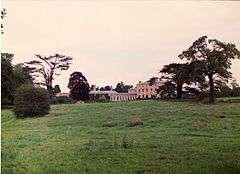Terling Place
| Terling Place | |
|---|---|
 | |
 | |
| General information | |
| Architectural style | Georgian |
| Location | Terling, Essex, England |
| Coordinates | 51°48′08″N 0°34′15″E / 51.8021°N 0.57097°ECoordinates: 51°48′08″N 0°34′15″E / 51.8021°N 0.57097°E |
Terling Place is the Georgian family seat of Baron Rayleigh and the largest house in the village of Terling.
It was built for John Strutt, MP between 1772 and 1777 to the designs of John Johnson. The wings, a new porch, a two-storey saloon (with a gallery, and a frieze based on the Elgin Marbles) and a library were added between 1818 and 1824. The house was redecorated in 1850, when a conservatory was added. It is a Grade II* listed building.[1][2]
From John Strutt the house passed to his eldest surviving son, Joseph, whose wife Lady Charlotte FitzGerald was created Baroness Rayleigh in 1821.
The 3rd Lord Rayleigh established a laboratory in the west wing (since lost to fire) where he first isolated argon in 1894, for which he was awarded the Nobel Prize for Science in 1904.
References
- ↑ "Terling Place, Terling". British Listed Buildings. Retrieved 3 December 2014.
- ↑ Historic England. "Terling Place (Grade II*) (1123407)". National Heritage List for England. Retrieved 3 December 2014.